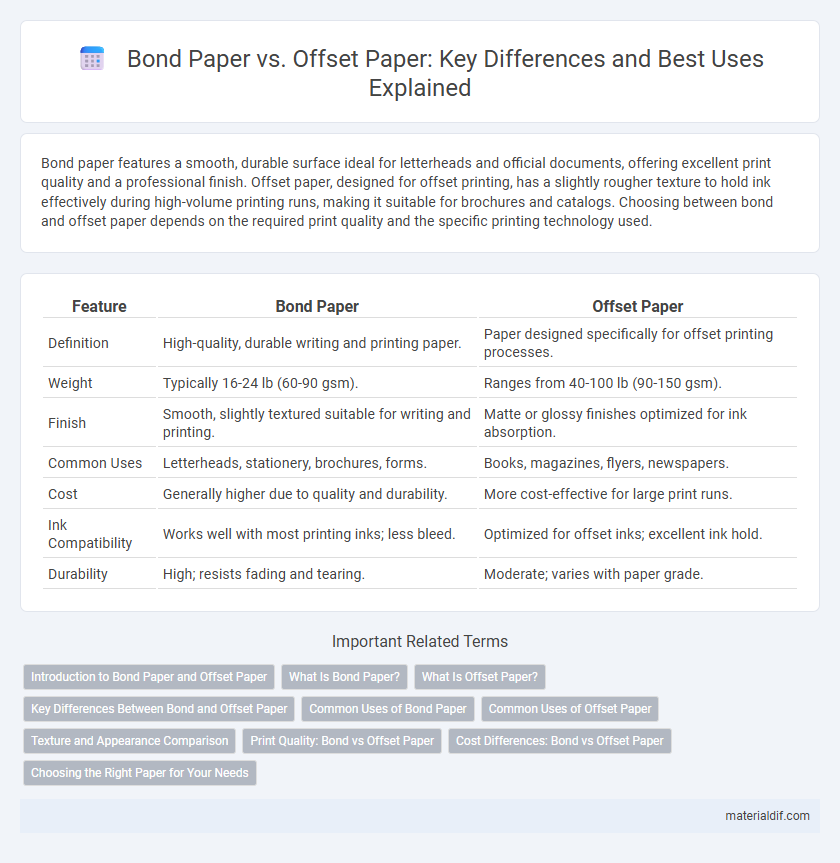Bond paper features a smooth, durable surface ideal for letterheads and official documents, offering excellent print quality and a professional finish. Offset paper, designed for offset printing, has a slightly rougher texture to hold ink effectively during high-volume printing runs, making it suitable for brochures and catalogs. Choosing between bond and offset paper depends on the required print quality and the specific printing technology used.
Table of Comparison
| Feature | Bond Paper | Offset Paper |
|---|---|---|
| Definition | High-quality, durable writing and printing paper. | Paper designed specifically for offset printing processes. |
| Weight | Typically 16-24 lb (60-90 gsm). | Ranges from 40-100 lb (90-150 gsm). |
| Finish | Smooth, slightly textured suitable for writing and printing. | Matte or glossy finishes optimized for ink absorption. |
| Common Uses | Letterheads, stationery, brochures, forms. | Books, magazines, flyers, newspapers. |
| Cost | Generally higher due to quality and durability. | More cost-effective for large print runs. |
| Ink Compatibility | Works well with most printing inks; less bleed. | Optimized for offset inks; excellent ink hold. |
| Durability | High; resists fading and tearing. | Moderate; varies with paper grade. |
Introduction to Bond Paper and Offset Paper
Bond paper is a high-quality, durable writing paper commonly used for letterheads, stationery, and official documents, characterized by its smooth texture and brightness. Offset paper, designed specifically for offset printing processes, offers excellent ink absorption and color reproduction, making it ideal for magazines, brochures, and newspapers. Both bond and offset papers vary in weight and finish, catering to distinct printing needs and visual outcomes.
What Is Bond Paper?
Bond paper is a high-quality durable writing paper originally used for official documents and letterheads, characterized by a weight range of 16 to 36 pounds and a smooth finish that resists bleeding and smudging. It is typically made from cotton fibers, which contribute to its strength and longevity, making it ideal for printing important correspondence and legal documents. Unlike offset paper, bond paper offers superior texture and is commonly used in professional office environments for resumes, reports, and stationery.
What Is Offset Paper?
Offset paper is a high-quality, uncoated paper specifically designed for offset printing, known for its smooth surface and superior ink absorption properties. It typically contains a balanced weight of pulp and additives to ensure durability, consistent texture, and vibrant image reproduction. Commonly used in commercial printing for brochures, posters, and magazines, offset paper provides excellent print clarity and color fidelity due to its optimal porosity and brightness levels.
Key Differences Between Bond and Offset Paper
Bond paper exhibits a smoother texture and higher brightness, making it ideal for everyday printing, letterheads, and official documents, while offset paper features a rougher surface designed for high-quality printing presses. Bond paper typically has greater durability and weight options ranging from 16 to 36 pounds, whereas offset paper is heavier, favoring weights from 50 to 100 pounds to withstand the mechanical stress of offset lithography. The chemical composition also differs; bond paper contains higher cotton fibers for strength, whereas offset paper uses wood pulp optimized for ink absorption and color fidelity.
Common Uses of Bond Paper
Bond paper is commonly used for official documents, letterheads, and stationery due to its high durability and smooth finish. It is ideal for printing, writing, and copying, making it a preferred choice in offices, schools, and legal environments. Its ability to handle ink well without smudging ensures professional quality for reports, forms, and resumes.
Common Uses of Offset Paper
Offset paper is primarily used for high-volume printing tasks such as magazines, brochures, catalogs, and newspapers due to its smooth surface and excellent ink absorption. Its durability and ability to withstand intense printing processes make it ideal for commercial printing and marketing materials. Offset paper's versatility also extends to business forms and flyers, providing consistent print quality across various formats.
Texture and Appearance Comparison
Bond paper features a smooth, uniform texture that enhances readability and is commonly used for official documents and letterheads, while offset paper typically has a slightly rougher surface designed to absorb ink efficiently for printing presses. The appearance of bond paper is bright white with a clean finish, providing a professional look, whereas offset paper often presents a matte or dull finish with a natural, uncoated surface that supports high-quality image reproduction. These differences in texture and appearance significantly affect printing results and the tactile experience, influencing the choice between bond and offset paper for various printing needs.
Print Quality: Bond vs Offset Paper
Bond paper typically offers a smoother surface ideal for crisp text and sharp lines, making it suitable for high-quality document printing. Offset paper, with its textured finish, absorbs ink differently, providing more vibrant colors and greater depth in printed images. Choosing between bond and offset paper depends on the desired print quality, where bond excels in clarity and offset in richness of detail.
Cost Differences: Bond vs Offset Paper
Bond paper typically costs more than offset paper due to its higher quality, durability, and smoother finish, making it ideal for professional documents and letterheads. Offset paper is more economical and widely used for bulk printing tasks such as newspapers and flyers, where cost efficiency outweighs premium texture. Businesses aiming to minimize printing expenses often select offset paper, while those prioritizing presentation opt for bond paper despite its higher price.
Choosing the Right Paper for Your Needs
Bond paper, known for its durability and smooth finish, is ideal for official documents, letterheads, and everyday printing, offering excellent opacity and a professional look. Offset paper, designed for high-volume printing, features a flat, uncoated surface that absorbs ink well, making it perfect for brochures, magazines, and mass-produced materials. Selecting the right paper depends on the specific print job requirements, such as print quality, durability, and intended use, ensuring optimal results and cost-efficiency.
Bond Paper vs Offset Paper Infographic

 materialdif.com
materialdif.com